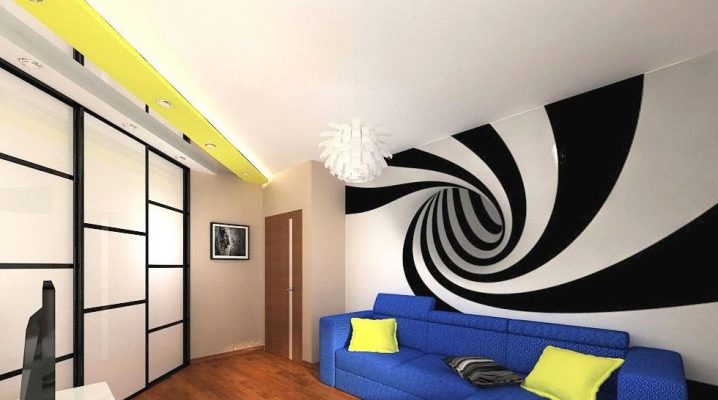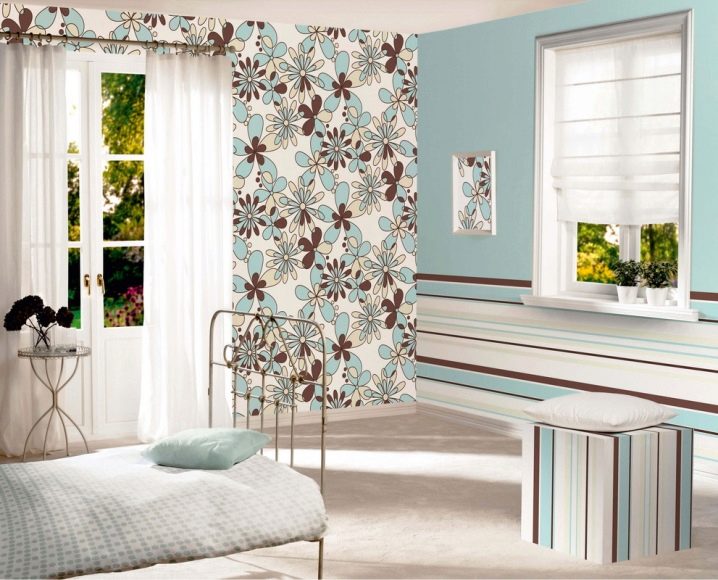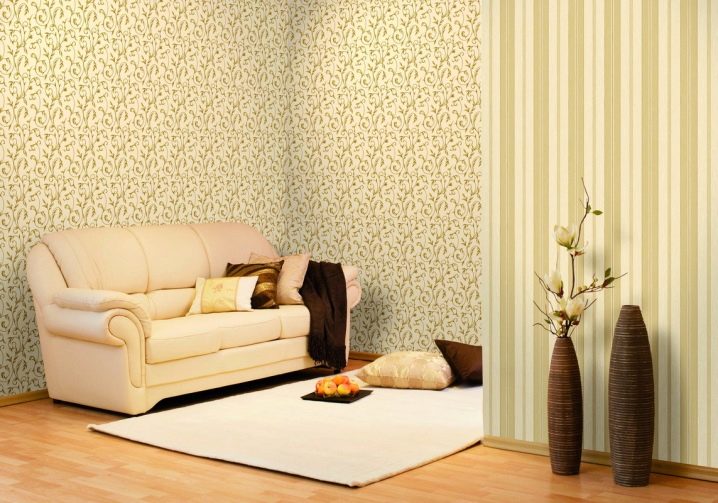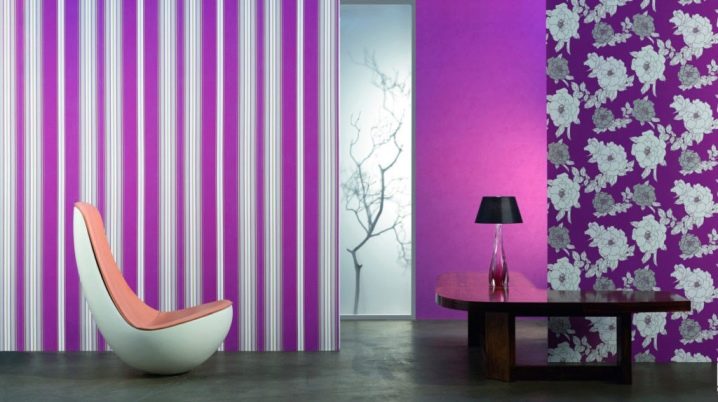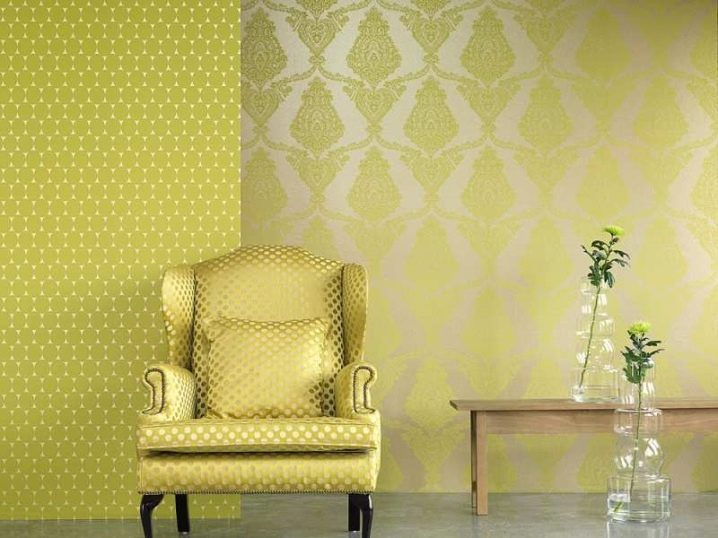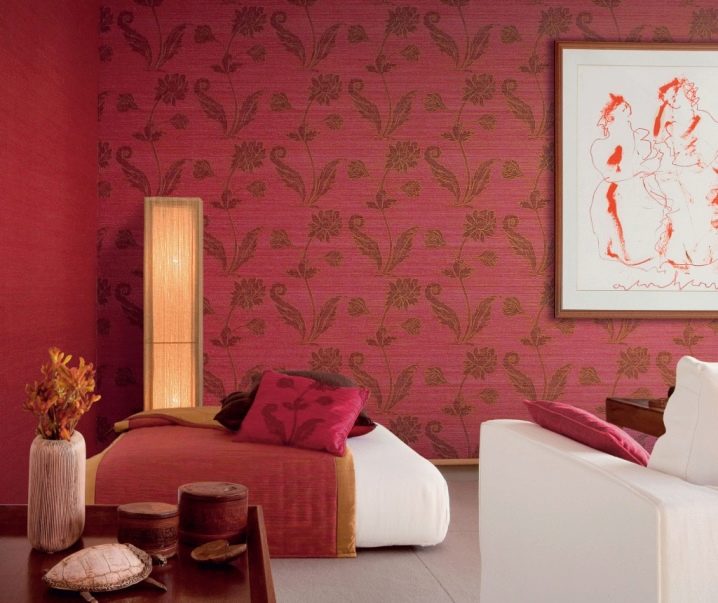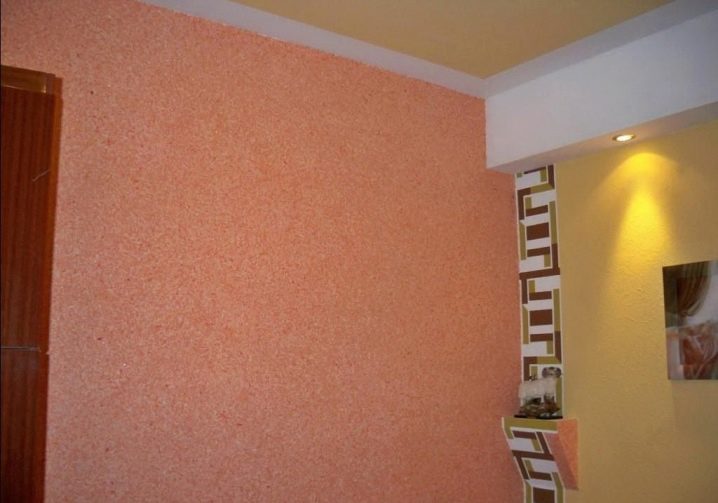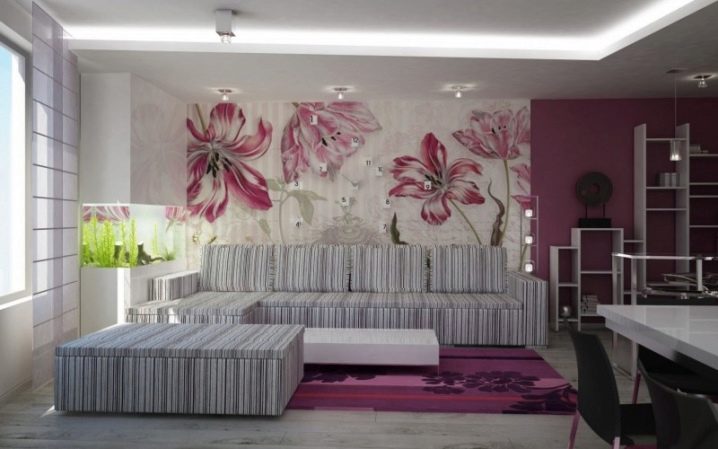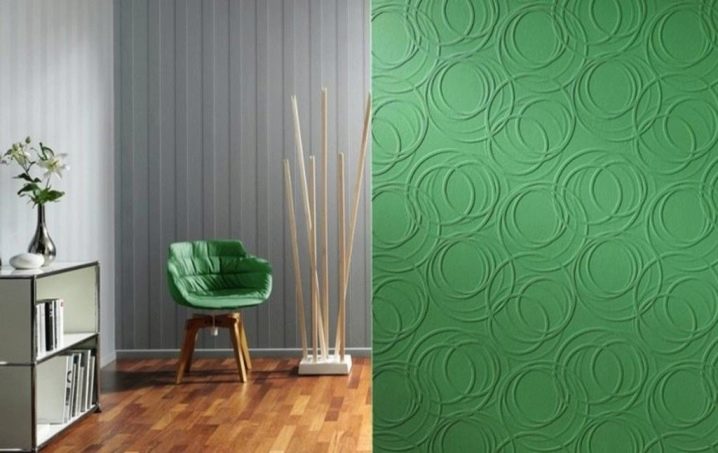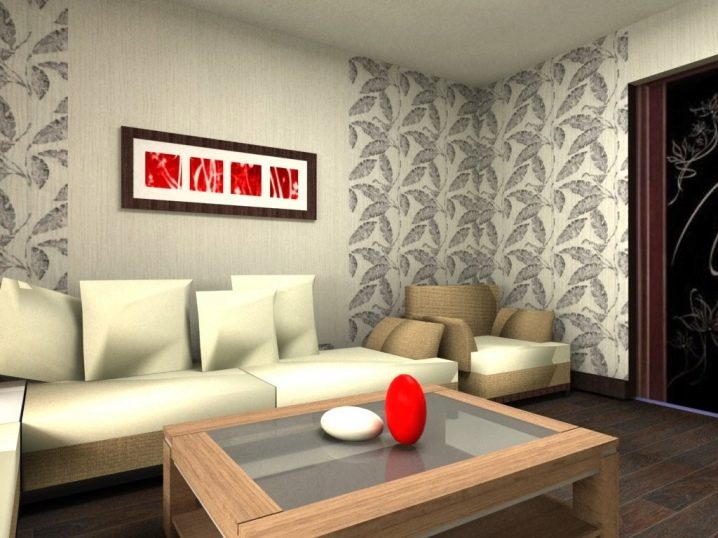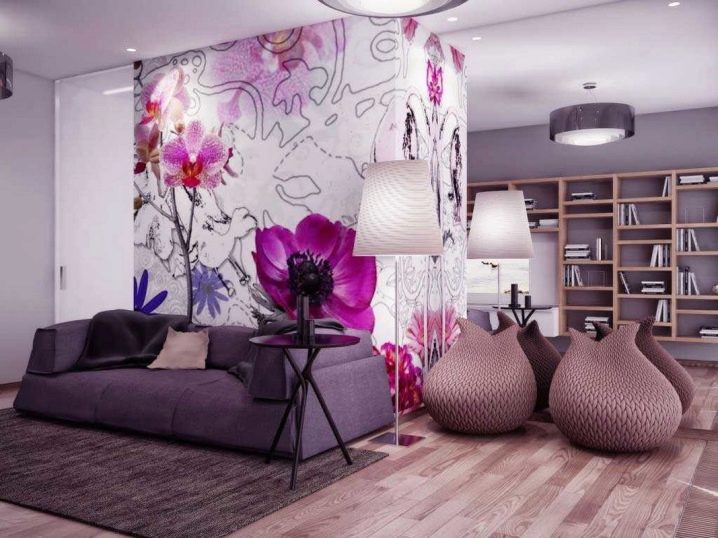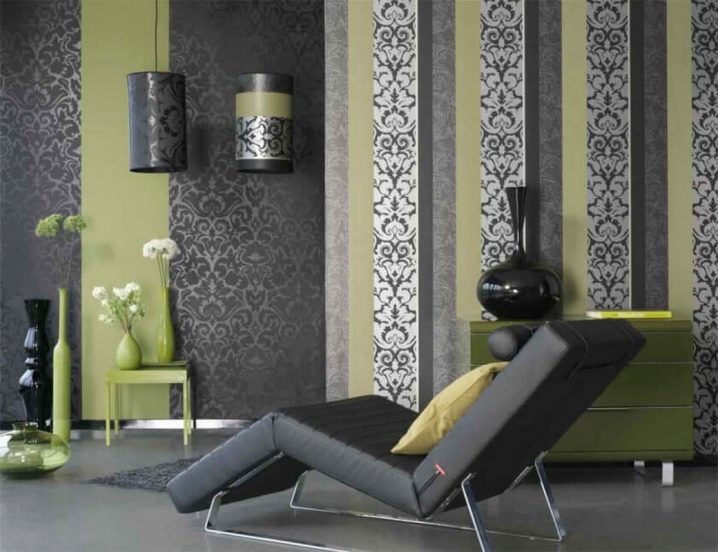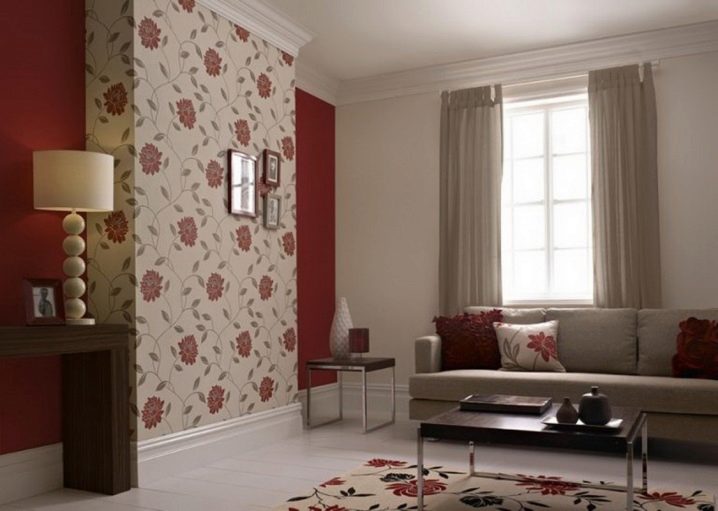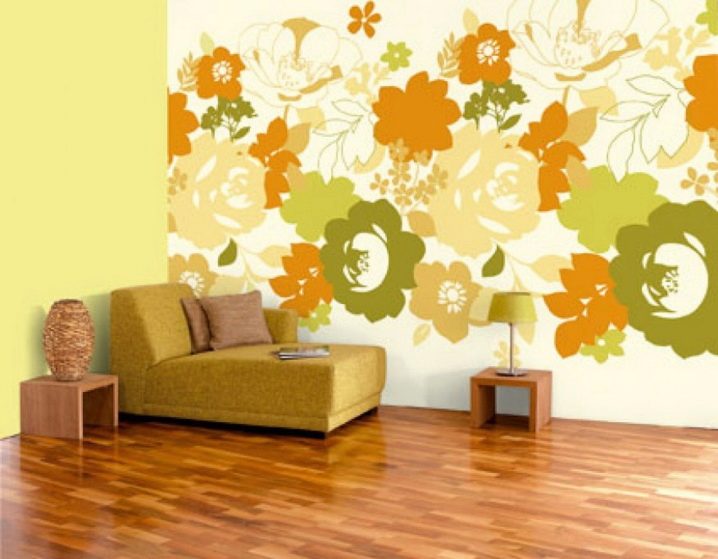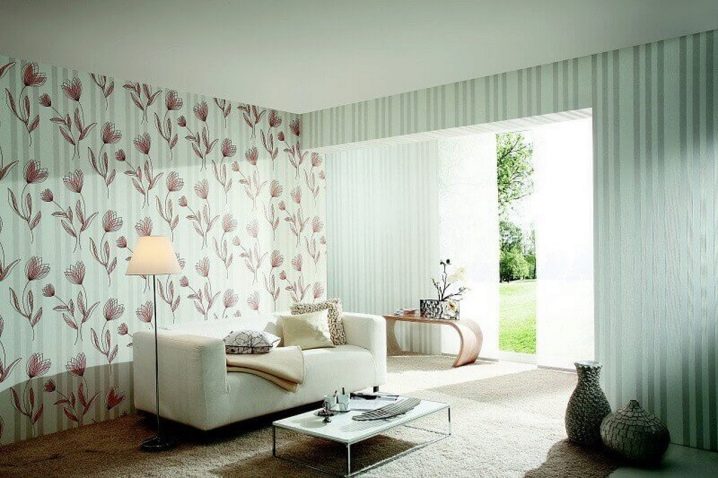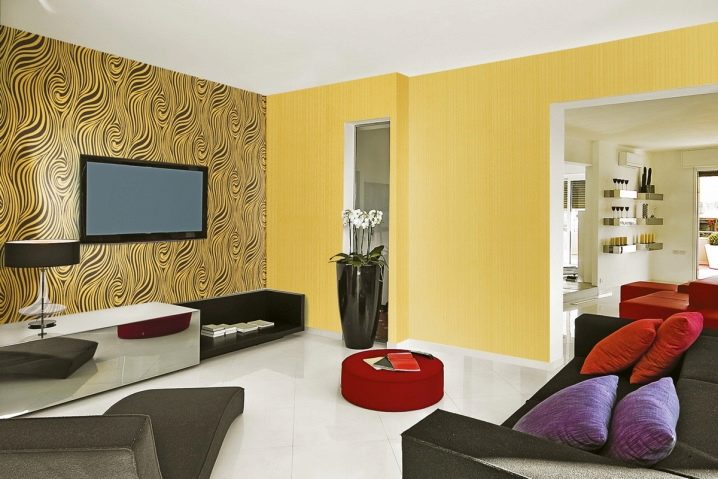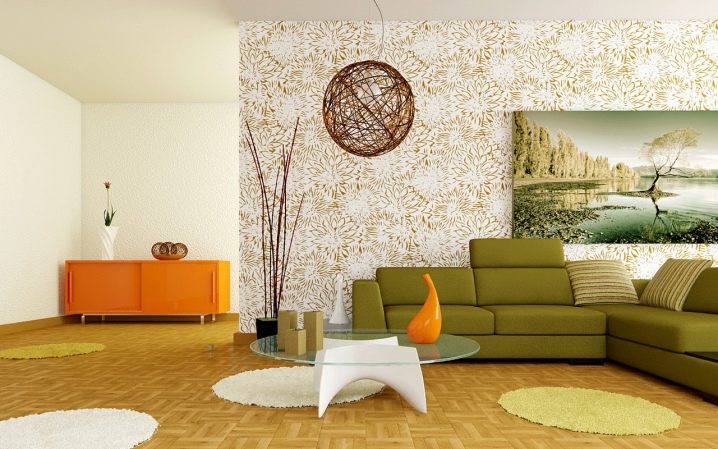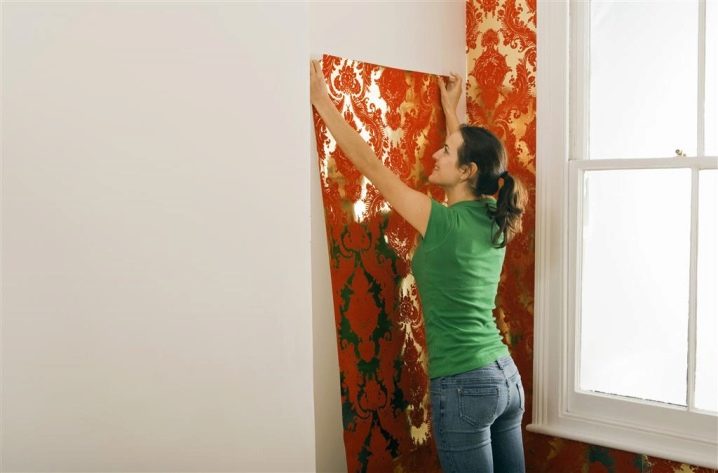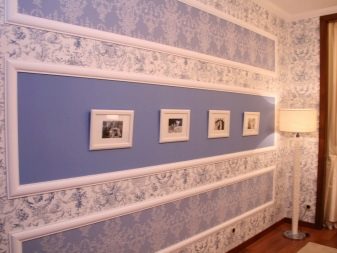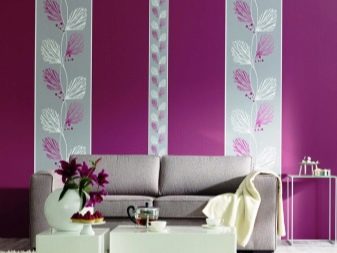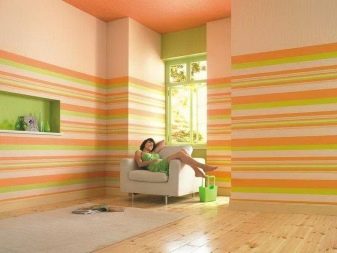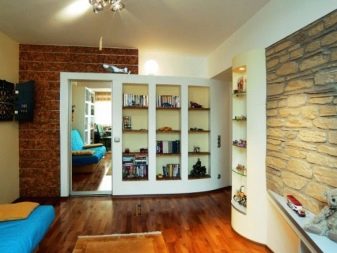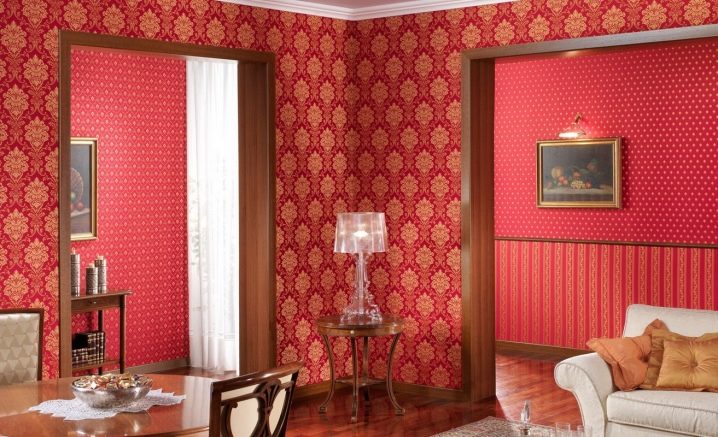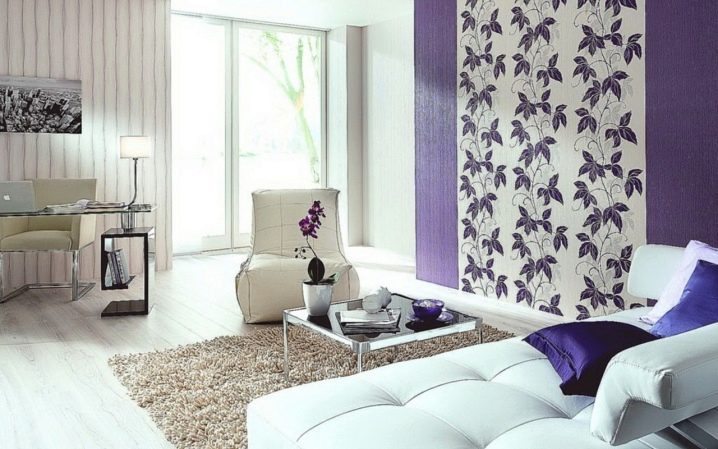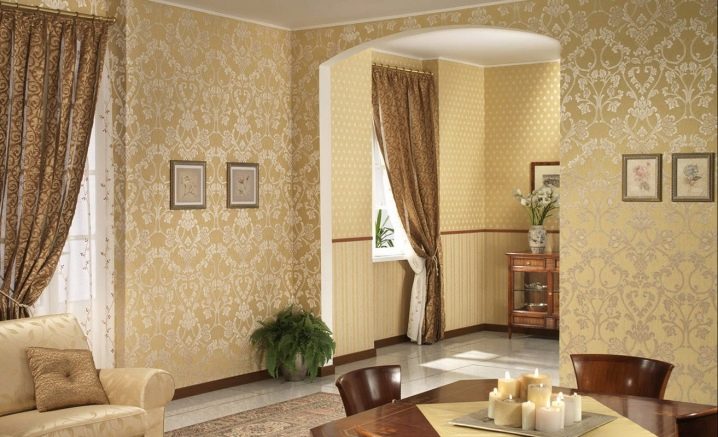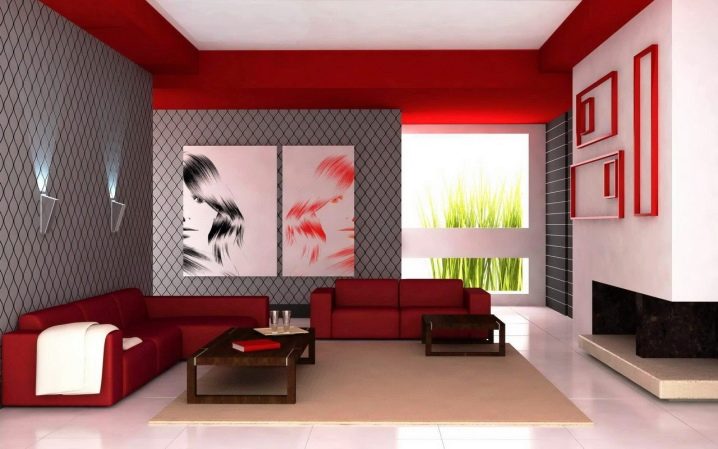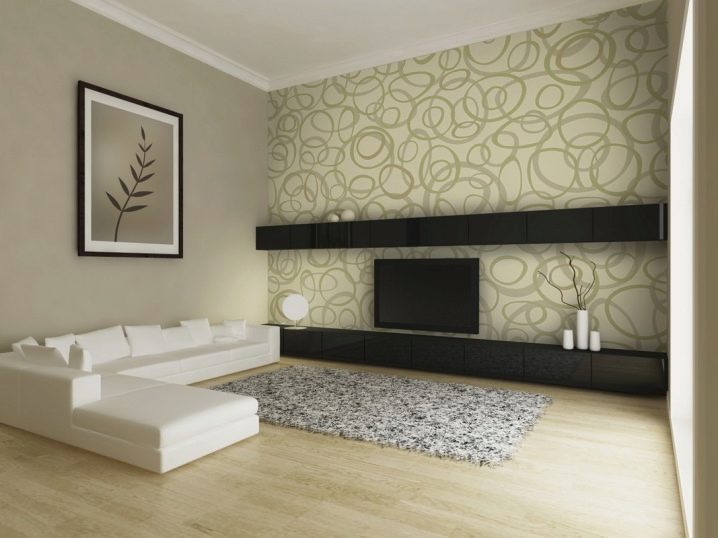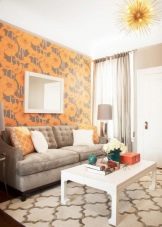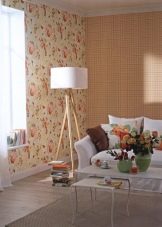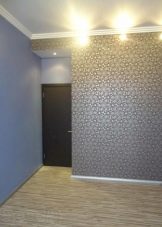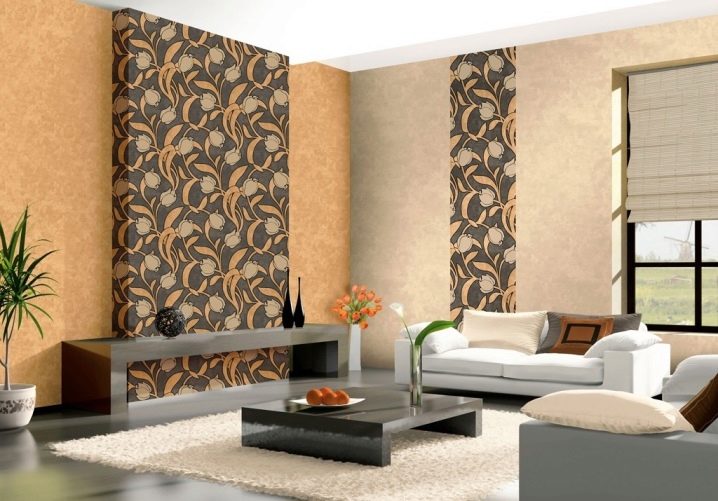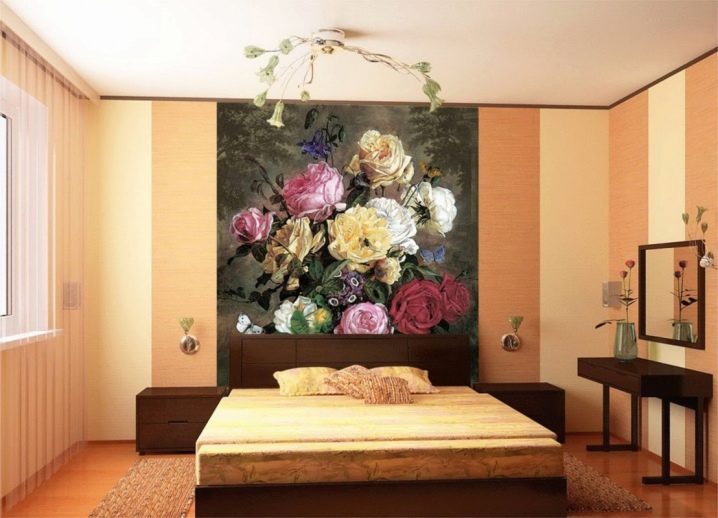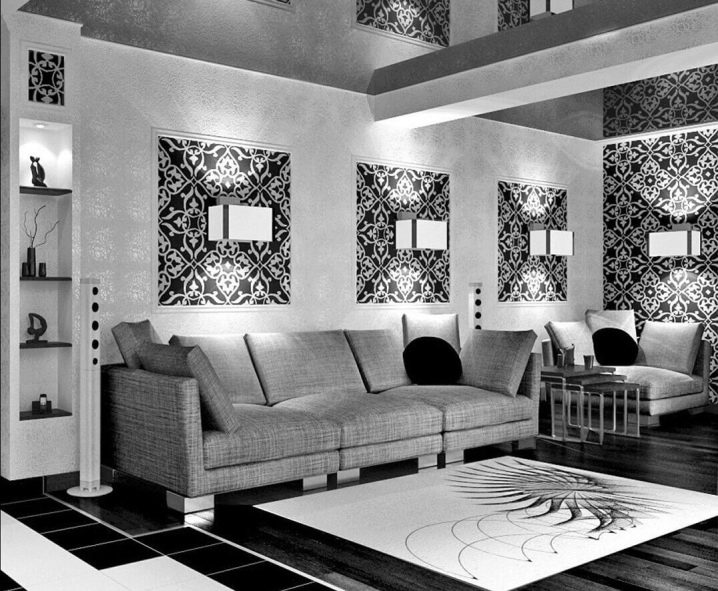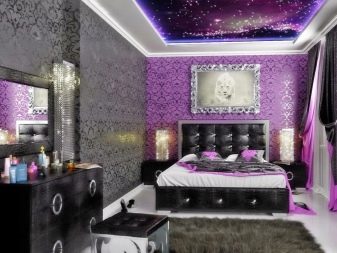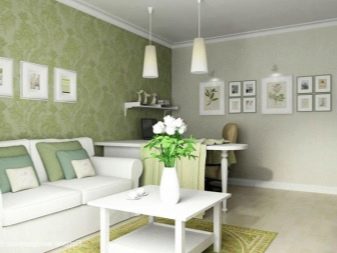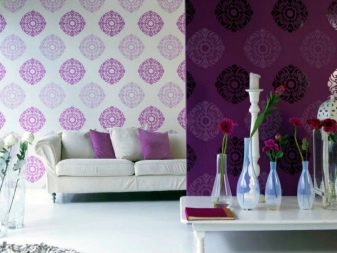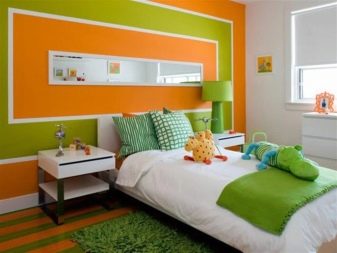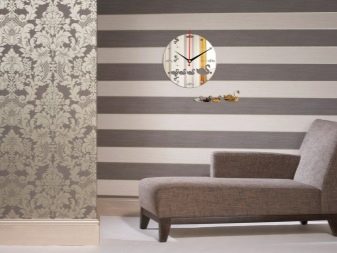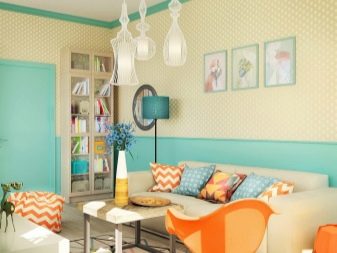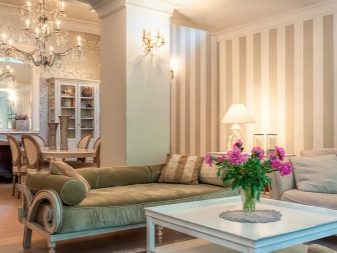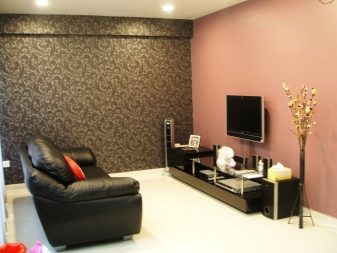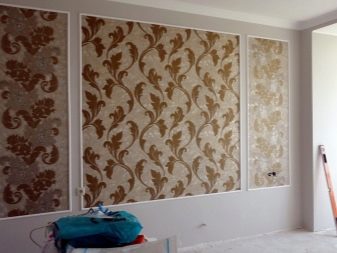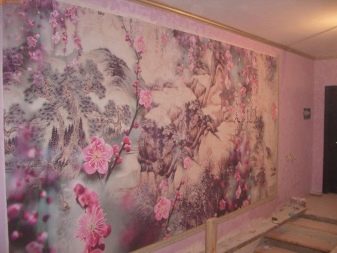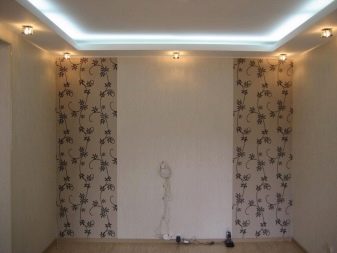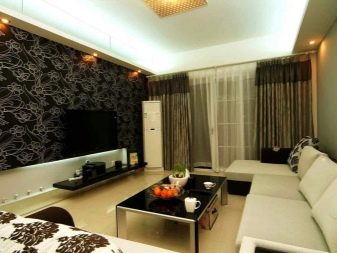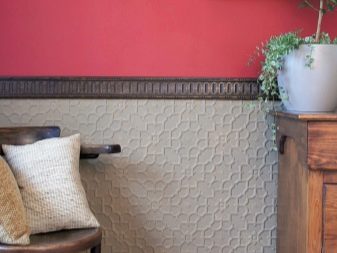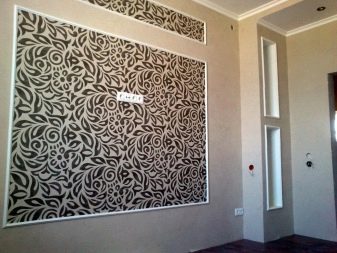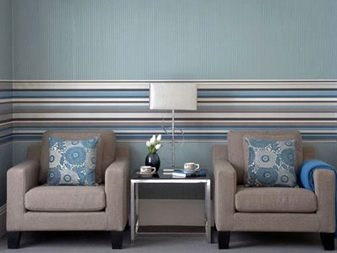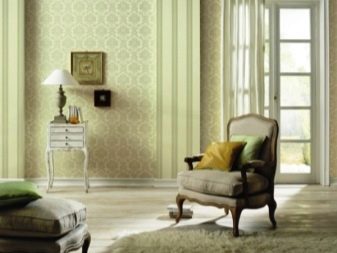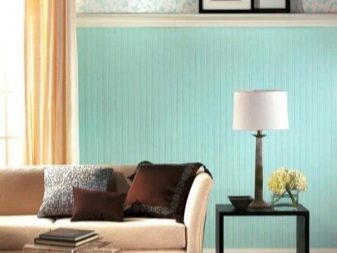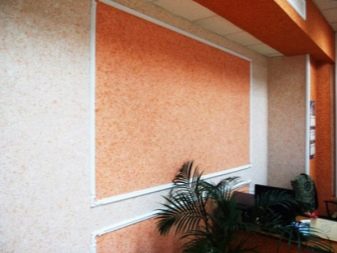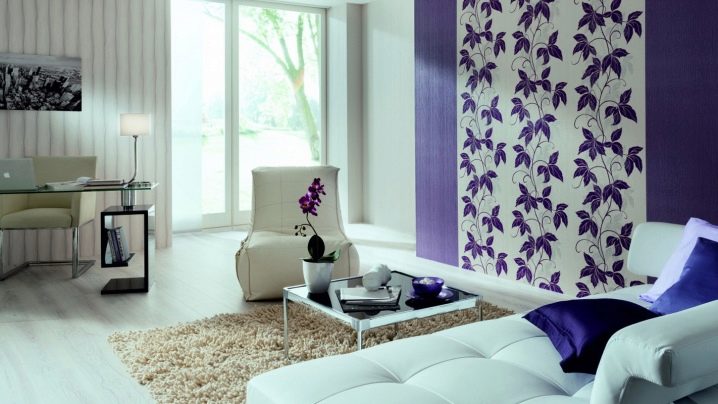Sticking wallpaper of two kinds in the hall
Facing the walls of the hall with the same wallpaper is a thing of the past, giving way to stylish design solutions for decorating the space. Today, the focus of attention is on the combination of design reception, which makes it possible to beat all the features of the room, advantageously emphasizing the desired zone.
What are suitable?
Reception combination allows the use of different types of finishes. Each material is different advantages, although not without flaws.
The most popular of them are:
- paper - mostly bilayer, able to hold out on walls for up to 5 years (budget alternative, low-resistant to the effects of steam and moisture, it looks simple);
- vinyl - an elite roll finish capable of correcting wall irregularities,including canvases with solid, smooth, porous structure and embossing, calculated up to 15 years of operation (harmful, since it releases formaldehyde vapors into the air);
- non-woven - elastic canvas meter width, characterized by practicality, color fastness, resistance to the effects of random mechanical touches, durability, attractive texture, but attracting dust;
- textile - wallpapers with a premium face, which are an excellent choice for the hall as an accent, made in the form of interlaced threads and closely located textile fibers glued onto a paper base (a fancy finish that is instable to moisture);
- liquid wallpaper - coatings in the form of a powder or a finished mixture, which, after lining, must be covered with a layer of acrylic lacquer to increase practicality (eco-friendly finishing as an accent, demanding in choosing a companion, since it has a special volume texture);
- photo wallpapers - the classic combination technique, which is a wallpaper on a paper basis in the form of a solid pattern-accent or canvas with image fitting (their weakness is the fear of ultraviolet radiation);
- glass wallpaper - glass fiber cloth with its shaping by means of special impregnations. This is a wallpaper with original texture and good performance.
Advantages and disadvantages
It is no secret that each room has its own characteristics. Combining two different materials of the same line is a non-standard solution for interior composition, through which you can perform a number of tasks. This technique involves a combination of facing plain wallpaper and canvas with a pattern. The uniqueness of the idea lies in the fact that the print can be made with paints, photo printing, embossed, it can also be presented in the form of texture.
The raw materials used for this decor are notable for their diversity: the materials on the market are full of beauty shades, versatile themes, and an extraordinary texture. Each type of lining has its pros and cons, provides for a combination, differs by the richest color gamut and different performance characteristics.
By accepting the combination, you can mask the irregularities of the walls, paste the most practical companions in the right place, beating the different possibilities of wallpaper (for example,using washing in places with increased likelihood of contamination).
Design approach has a lot of advantages.
Combining wallpaper of two types allows you to:
- beat the design features of the room, deliberately highlighting the ledges, niches, panels, turning the lack of space into bright accents of style;
- to muffle an unnecessarily bright and patterned companion by means of a calm contrast, saving the interior from an abundance of variegation and oppressive atmosphere;
- emphasize a favorable place in the room, thereby diverting from unsightly angles, emphasizing the uniqueness of the design;
- to zone premises on certain functional areas, thereby introducing an unobtrusive organization into the space;
- to reduce the material consumption for the fitting of the pattern, if necessary using the remnants of the canvases from the adjacent rooms;
- to give the room individuality, using beautiful examples of experienced interior designers, adjusting them to the characteristics of the hall and their taste preferences;
- change the aesthetic perception of the room by infusing the desired shade, pattern, adding lighting and temperature to the decor;
- to combine together the separate pieces of existing furniture and other elements of the interior (curtains, puffs, throw pillows, table lamps, floor lamps, wall lamps, paintings, etc.);
- choose your “color type”, thereby creating the right mood and increasing the potential, making the atmosphere of the room home-like cozy;
- give space the desired status by combining expensive and fashionable texture that matches the furniture;
- depending on the shades used, their saturation and the size of the pattern, create a stylish interior in a classic, ethnic or modern design, pointing out its idea;
- to save space from boredom and everyday life, filling it with fresh paints.
Combining wallpaper has a lot of possibilities for design: modern manufacturers, knowing this technique, offer for sale paired canvases that are not limited in scope. In addition, on the shelves of shops there is always wallpaper in any style, whether it be classic flowers or creative abstraction.
If you wish, you can always choose a combination based on your own preferences and the budget planned for the purchase.
disadvantages
It is not always the combination of two types of wallpaper harmoniously. This may be due to several reasons.
One of them is the rule of compatibility of texture: not all canvases, different in composition and appearance, can be mixed. For example, smooth paper wallpapers simplify the look of vinyl or embossed textile options.
They do not fit flizelinovym: finish should be chosen based on the status of each type. To make the reception successful, you should beat it using photo wallpapers.
Different width and a relief have value. Porous thick wallpapers, combining with thin paper or smooth non-woven, do not create a feeling of solidity, so they look fragmented and resemble hastily glued veneer residues. Some canvases are difficult to select due to the lack of identical shades.
The method of combining two wallpapers has disadvantages:
- it does not always give the desired effect and expressiveness;
- out of place in small-sized rooms, as when using large drawings it creates a feeling of congestion and limited space;
- does not look beautiful and stylish, if made unprofessionally, thoughtlessly, without a pre-prepared sketch;
- requires a clear place for each piece of interior, otherwise loses expressiveness;
- compares each element of the furniture with itself, therefore it implies stylish furnishing and does not accept extra details that overload the overall look;
- by no means always draws out the adjustment of the room-trapezoid with a broken perspective, giving it an even more awkward look, visually skewing the walls;
- Often has a bad print in the form of small strips, peas, cells that create ripples in the eyes, annoying within a few days after pasting.
How can I glue it?
Ways of sticking wallpaper of two types are multifaceted. There are several original design techniques that are worth considering.
The size of the picture, the color of the canvas and the texture depend on the height of the ceiling. If it is low (2.5 m), the shades should be light, the pattern should be small, the texture should be soft. If the ceilings are low, it is preferable to perform a combination using strips or linen without a pronounced pattern with a uniform coating.
With a high ceiling harmonious large print, stretched in width or horizontal stripes.
The pasting rules dictate the size of the hall: the larger it is, the brighter the shade can be, the more expressive the pattern.If the room is narrow, you can perform a combination with the entry of the canvas on a long wall. This will allow you to beat the flaws of the layout.
In cases where the entrance to the room falls on the narrow side, it is necessary to select the opposite wall in a contrasting color, beating the corners with wallpaper for short walls. Additionally, you can use special vinyl-based stickers: they perfectly correct the flaws in the layout.
Use the techniques of combining experienced designers:
- horizontal - a stylish solution in which wallpaper is glued parallel to the floor through the use of cloths with the original texture or alternation of exclusively paired wallpapers with a smooth transition of the print;
- vertical - a classic technique that allows you to divide the walls vertically: highlighting the contrast in the form of two or three strips of wallpaper with a pattern (maximum of one wall) and smoothing the other planes with monochromatic canvases;
- decorating walls with panels - sticking basic monochrome wallpaper with the addition of small fragments of accent canvases framed in moldings or ceiling plinth to the wall surface;
- emphasis on bumps and niches - highlighting the design features by gluing contrasts or smoothing them with monochromatic companions.
How to avoid mistakes?
To avoid common mistakes, it is worth considering a few simple rules:
- if the space of the room is small, exclude from the list of preferences wallpaper with a large print that does not correspond to reality (large elements of the decor have a pressing effect);
- eliminate the combination of different styles: ethnic, and modern, antiquity and manufacturability, conservatism and abstraction (they can not be combined into a duet);
- buy canvases at the same time, if possible, with natural light: you can check them for compatibility of tones;
- if there are no combination skills, it is better to buy a contrast with a pattern of several shades: it will be easier to pick up a calm companion to it (it is better to buy photo wallpapers);
- do not make the combination of alternating stripes of the same width: it is tasteless, crushes the room into parts, gives the room a sense of being in a gypsy tent;
- exclude reception diagonally: in most cases, this leads to a visual skew of the wall;
- bright and hot colors irritate the psyche and provoke eye pain, it is better to dilute the bright contrast with a pastel companion;
- the combination of floral design with textural ornaments should be dosed: an abundance of contrast overloads the room and quickly becomes boring;
- do not confuse brightness and tone: shades can be combined in tone, but the brightness of two companions is unacceptable, only one can dominate.
The meaning of using the combined wallpaper is that the room was individual, beautiful and cozy. You do not need a lot of contrast and variegation: so the print loses importance. The unity of style is achieved by moderation. Contrast color is necessary to highlight the details of the pattern or a specific area of the hall. It is applied only on one wall or in one place of the plane.
It is extremely important that the room be kept in the same style, otherwise the acquisition of uniqueness is impossible, the combination is devoid of meaning and will not have the desired effect.
From different materials
It is quite possible to create effective wall cladding with different materials without imbalance. It is extremely simple.If there is a sense of taste, you can combine different finishes, while it will look appropriate, comfortable and fashionable.
To correctly and harmoniously combine the wallpaper of two kinds, it is worth:
- select canvases of the same thickness (this will reduce the accentuation of the joints and make the vertical transitions of the paintings imperceptible);
- pay attention to the texture: the glossy surface simplifies any canvas, so it is better to replace it with embossed, and matte often needs the same support of a companion;
- pay attention to color: at least one of the contrasting shades of the two canvases should be common;
- to understand the purpose of the room: it is inappropriate to glue wallpapers with funny children's drawings or bathroom themes to the walls of the hall;
- determine the dominant: the print accent should not be large;
- select contrasts deliberately: the animalic print cannot be combined with peas, stripes, zigzags, colors.
Different sizes
For the combination to be harmonious, the sizes of the canvases must be different. The selected method is appropriate in one room, so the repair will look unique and stylish. The combination of different sized drawings must be careful: it is permissibleonly in a spacious room. The print may be different, but on two canvases the large size is unacceptable.
The modern approach allows the use of pasting colors repetition through texture. It can be an animal print and wallpaper with a plush or velor texture, canvas with monograms and a companion with imitation of stucco plaster, a mix of floral motifs and embossed divorces in the form of curls. The main thing that is worth understanding is: two drawings more often overload the room than fill it with the desired effect.
Color combinations
The main criteria for choosing a shade are psychology and color combination. To do this, you can refer to the color circle, which will demonstrate the correct layout of contrasts.
It is important to remember: warm shades (beige, cream, peach) give comfort and a relaxing atmosphere, fresh tones (mint, blue, blue-green) are able to bring coldness and lethargy into space.
Eliminate the abundance of blue and purple: they have a negative effect on the psyche, causing depression in older people. If you want freshness, you should look at the contrast of beige and turquoise tones. The abundance of orange, red is unacceptable.
Monochrome gamma can cause a negative: it is necessary to combine black and white shades moderately. It is more expedient to beat the contrast using a gray pattern with silver sputtering or embossed on a white background, supporting the decor with furniture with black decor.
The embossing technique makes the room luxurious: made in coffee, lilac shades, it will look stylish if it is shaded by a solid-colored companion without a shine. To tie the two canvases together, you can stick stickers on calm wallpapers or hang pictures, the color of the drawing of which coincides with a bright print.
The best combinations are:
- green and beige;
- lilac and silver;
- olive and orange;
- lilac and fuchsia;
- sand and diluted turquoise;
- white, gray and silver;
- cocoa color with milk and pink;
- coffee, beige and gold.
Design Ideas
Combining two types of wallpaper will look fashionable, beautiful and stylish if:
- glue on one wall a bright contrast, smoothing it with a monophonic canvas with a transition to the side of the accent;
- place the three walls and the center of the fourth light monochromatic wallpaper, arranged on the sides of one accent strip;
- choose two canvases with the same texture, but of different shades, gluing the accent in the middle of the wall, framing the edges with light panels with curved lines;
- highlight the area at the head of the head, closing the joints of the paintings with a border or molding;
- glue plain wallpaper on all the walls, accentuating one of them with a large rectangular insert framed in the ceiling plinth;
- repeat the print of the wallpaper in the pattern of curtains, provided that they are located on the walls with plain canvases;
- glue the fourth plain wallpaper on all the walls and top, marking the bottom in the form of contrast panels;
- having made the three walls calm, decorating the top with a bright accent, and the bottom with plastic panels.
Interesting examples and options
In order to visually understand what constitutes a combination of two types of wallpaper in the interior, you should refer to interesting design examples. Textured stripes and delicate wallpaper with mint leaves look great with molding, support in the form of beige curtains and light-colored furniture.
Small wallpaper with monograms and a strip accentuating the ledges of the living room, made in a diluted gray-green color, are harmonious with the support of the white color of the window and ceiling,similar floor plinth, bleached color of a floor, dark furnish of furniture and accessories.
The interior of the living room in beige tones will be decorated with an unobtrusive accent in the form of lace wallpaper: in order to be harmonious, it is worth adding curtains of a similar pattern in a coffee shade to it.
Liquid wallpaper is best combined with each other by means of panels or individual geometric figures: peach cloths decorated with white plinth against a cream wall look harmoniously, a bright contrast can be supported by the design of the room projections.
In order to have a lot of light in the living room, sticking in violet-white tones with a light gray monochromatic companion, delimiting the space of the room into functional zones, is suitable.
How to combine wallpaper of two colors in the hall, see the following video.
